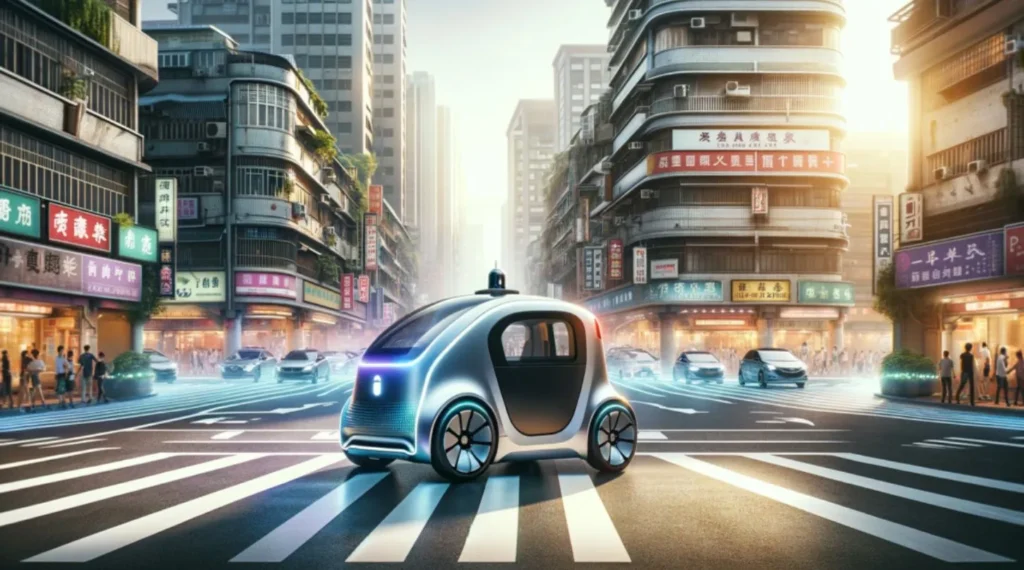The dynamic city of Taipei, which is rooted in both modernity and history, is about to transform its urban environment with the Taipei Self-Driving Gharry, an inventive hybrid of the past and present. This ground-breaking project revitalizes the legendary gharry by skillfully fusing the allure of a bygone age with the usefulness of autonomous driving.
In this comprehensive investigation, we will peel back the many layers of this innovative project, delving into its conception, intricate technical workings, wide range of benefits, present development, and the bright future it holds for Taipei.
Concept Unveiled:
We start our voyage by imagining a classic gharry, a charming horse-drawn open-air carriage that is currently experiencing a fundamental change. The sound of hooves is replaced by the buzz of an electronic motor, and a very advanced self-driving system takes control of the reins. The Taipei Self-Driving Gharry is a creative fusion of the old and the new. By creating a story that balances tradition and technology, this idea brings the cultural legacy of gharry riding into the twenty-first century.
Technological Marvel:
A combination of cutting-edge technology takes center stage at the heart of this creative endeavor. Together, LiDAR, radar, and cameras form the gharry’s sensory framework, enabling it to navigate Taipei’s complex street network with unparalleled precision and skill. This sensory data is analyzed by state-of-the-art algorithms, enabling the gharry to follow pre-planned routes and react to traffic signals with ease. The electric motor is a powerful yet silent force that is essential to sustainability and marks a major advancement in ecologically aware urban transportation.
Benefits Beyond the Ride:
By providing a whole experience that goes beyond simple transportation, the Taipei Self-Driving Gharry has an influence that is felt even outside of urban areas.
Tourist Attraction: The gharry is transformed into a singular spectacle that offers an immersive experience that alters visitors’ perceptions of the city, putting them in for a sensory feast. Technology and tradition together create a memory that lasts a lifetime and calls people back.
Cultural Preservation: Taiwan manages a careful tango between the past and future by adopting self-driving technology. In order to preserve the gharry riding custom as a lively part of Taiwanese identity, the Taipei Self-Driving Gharry takes on the role of a protector of cultural heritage.
Economic Boost: The project becomes an economic stimulus in addition to its cultural relevance. Manufacturing, maintenance, and operation jobs are in high demand, which boosts the local economy and promotes a feeling of communal development.
Environmental Stewardship: Taipei’s dedication to environmental sustainability is bolstered by the electric motor, which is more than just a powerful machine. The city’s commitment to a greener future is demonstrated by its efforts to reduce noise and air pollution.
Current Status and Future Prospects:
By 2024, the Taipei Self-Driving Gharry will have reached a critical point in its development. Pilot projects and comprehensive testing are in progress, laying the groundwork for a day when these self-driving carriages will be smoothly incorporated into daily life. Though it is not yet available to the public, the city is a hive of activity as it awaits the wider adoption of this innovative technology. In addition to showcasing technical innovation, Taipei’s Self-Driving Gharry represents the city’s commitment to protecting its rich cultural legacy while advancing into a bright and innovative future.
The Evolution of Taipei’s Transportation Landscape:
Understanding the Taipei Self-Driving Gharry’s place in the greater story of Taipei’s transportation development is essential to understanding its significance. Every significant development, from the historic gharry to the cutting-edge metro system, demonstrates the city’s adaptability and resiliency to shifting circumstances. The Taipei Self-Driving Gharry, with its innovative fusion of technology and tradition, emerges as a key character in this tale. This chapter encourages contemplation on the relationship between development and legacy.
Challenges and Considerations:
The Taipei Self-Driving Gharry represents a new age in urban mobility, but it’s not without its difficulties and limitations. Taipei has a number of challenging issues to resolve before autonomous cars and conventional forms of transportation can coexist seamlessly: legal frameworks, public acceptability, and the incorporation of autonomous vehicles into current traffic patterns.
Public View and Social Effects:
Analyzing how the Taipei Self-Driving Gharry affects society requires investigating how the general public views it. What is Taipei’s population’s opinion on this fusion of old and new? Are they prepared to accept a world in which driverless cars eventually replace horse-drawn carriages? Comprehending these subtleties is essential for assessing the project’s viability and likelihood of becoming a cultural landmark in Taipei’s history.
International Implications:
The accomplishment of the Self-Driving Gharry project has global ramifications beyond Taipei. The Taipei effort becomes a case study in using technology to revive traditional customs while addressing modern environmental concerns as cities across the world struggle with urban transportation issues. With great curiosity, the whole community observes, hoping to learn something that could change the course of urban transportation in the future.
ALSO READ:
Conclusion:
The Taipei Self-Driving Gharry’s introduction into the city’s dynamic urban narrative is a noteworthy development that skillfully combines the city’s traditional heritage with the promise of a cutting-edge, sustainable future. This comprehensive analysis explores the inception of this innovative project, revealing its theoretical foundations, technological intricacies, range of benefits, and complex network of difficulties and factors that come with integrating it.
Taipei is at a crossroads, straddling the lines between tradition and innovation, as it rapidly approaches the threshold of public accessible. The city is ready to throw wide its arms and embrace the new era of the self-driving Gharry. This project represents Taipei’s commitment to crafting a tale that skillfully blends the echoes of its past with the buzz of electric motors in the present. It goes beyond the progress of transportation. Within the colorful fabric of Taiwan’s capital, the Taipei Self-Driving Gharry is more than simply a way to move around—it becomes a representation of development, a steward of culture, and a dynamic force for change.


